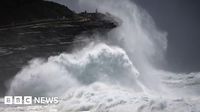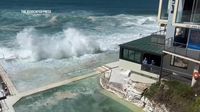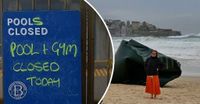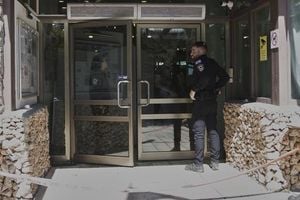A huge swell combined with a king tide battered Sydney’s coastline on Wednesday, April 2, 2025, causing significant damage to several iconic beaches, including Bondi, Cronulla, and Bronte. The powerful surf, which reached heights of up to 5.5 meters, wreaked havoc on coastal infrastructure and forced evacuations in some areas.
Residents living in Botany Bay were particularly hard hit, as they were forced to evacuate their homes late Tuesday night due to the inundation caused by the king tide and massive waves. Eyewitness reports described the scene as chaotic, with waves crashing over sea walls and flooding streets. Andrew Edmunds from the State Emergency Service noted, "Crews had to sandbag several properties, as waves several meters high crashed over the sea wall and flooded streets." This situation was compounded by the king tide, which peaked at nearly 2 meters.
At Bondi Beach, the famous Icebergs surf club suffered extensive damage. CCTV footage captured waves bursting through glass doors just after 11 PM on Tuesday, leading to the closure of the club's cafe, pool, and gym on Wednesday morning. A large water storage tank was also washed up on Bondi Beach overnight. Broken glass and debris littered the area, with reports of smashed windows and damaged railings.
Meanwhile, at Bronte Beach, the surging surf knocked over two brick walls and scattered debris throughout the park. Local authorities were quick to respond, closing the beach to ensure public safety. "These conditions are risky even for experienced surfers," warned veteran lifeguard Paul Moffatt, urging the community to stay out of the water as more large swells were expected.
Cronulla Beach also faced significant challenges, with waves exceeding 4 meters causing damage to the beach and esplanade. Sutherland Council lifeguard duty officer Steve Winner reported that the beach had been badly impacted, saying, "Last night there were waves over 4 meters. There are exposed electrical wires and pipes, and waves are still coming up." The council had to cordon off sections of the esplanade due to cratering in the concrete walkway.
As the storm system moved along the coast, residents across the Coffs Coast woke up to discover the extent of the damage caused by king tides and dangerous surf conditions. Sawtell resident Jeff Holmes expressed shock at the coastal erosion at his local break, describing it as one of the steepest cuts he had ever seen. "I've been here for 35 years, that's probably one of the steepest cuts I've ever seen on Sawtell main beach," he said.
In Dolls Point, approximately 20 properties were flooded, prompting emergency services to take action. Maree McCaskill, a long-time resident, described the flooding as unprecedented, stating, "I've never seen the waves nearly as high." The SES was actively involved in sandbagging properties to prevent further damage.
Further down the coast, Wamberal Beach experienced significant erosion, with residents expressing concern over the safety of their homes. Chris Rogers, a local resident, stated, "It's quite scary out there at the moment … there has been substantial erosion and concrete has fallen onto the beach." This area has been under pressure since severe storms in July 2020, with residents advocating for a seawall to protect their properties.
The Bureau of Meteorology recorded remarkable wave heights during this weather event, with 6.3-meter swells noted at the Eden wave buoy on Tuesday morning and 5.1 meters at Batemans Bay in the afternoon. A 5.9-meter wave was registered at the Port Kembla buoy early on Wednesday morning. This extreme weather prompted warnings from authorities about the potential for coastal erosion and damaging surf conditions across the New South Wales coast.
Emergency services were also involved in a dramatic rescue at Fisherman's Beach in Port Kembla, where two teenage boys were swept out to sea. Lifeguards, assisted by emergency services, managed to rescue the boys after they were carried 250 meters offshore.
As the situation unfolded, local councils and emergency services worked tirelessly to assess and respond to the damage. A spokesperson for Randwick City Council reported that beaches in their area would remain closed as workers assessed damage at Coogee Beach and along the coastal walk. Infrastructure at three beaches was reported damaged, and cleanup efforts were underway.
Despite the immediate threat of coastal hazards easing, authorities continued to urge caution. The New South Wales police advised people to stay out of the water and avoid walking near surf-exposed areas, while the SES warned of potential high tides later in the evening.
As residents begin the process of recovery, the long-term impact of this weather event remains to be seen. Coastal erosion experts predict that it could take months to recover from the damage inflicted by the massive swells and king tides. Stephan Soule from the National Marine Science Centre noted, "It's going to take a while, especially with the amount of sand that we've lost. It could be even longer than six months."
With more heavy swells forecasted for the coming days, the community is bracing for further challenges. The resilience of Sydney's coastal residents will be tested as they navigate the aftermath of this powerful natural event.








